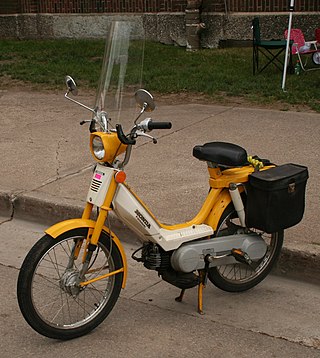
A moped is a type of small motorcycle, generally having a less stringent licensing requirement than full motorcycles or automobiles. Historically, the term exclusively meant a similar vehicle with both bicycle pedals and a motorcycle engine. Mopeds typically travel only slightly faster than bicycles on public roads.

Speed limits on road traffic, as used in most countries, set the legal maximum speed at which vehicles may travel on a given stretch of road. Speed limits are generally indicated on a traffic sign reflecting the maximum permitted speed, expressed as kilometres per hour (km/h) or miles per hour (mph) or both. Speed limits are commonly set by the legislative bodies of national or provincial governments and enforced by national or regional police and judicial authorities. Speed limits may also be variable, or in some places nonexistent, such as on most of the Autobahnen in Germany.
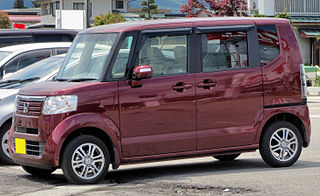
Kei car is the smallest category of Japanese, expressway-legal motor vehicles. 'Kei' is diminutive for kei-jidōsha,, "light automobile" or "compact automobile". With restricted dimensions and engine specifications, owners benefit firstly from lower taxes and insurance rates which lead to a lower overall cost of ownership. And in most rural areas, importantly, they were also exempted from the general Japanese shako shōmeisho (車庫証明書) parking-space ownership requirement to legally buy a motor vehicle at all, as street parking is generally restricted in Japan. Japan's carmakers also make microvans and kei trucks within this legal category.

Cruise control is a system that automatically controls the speed of an automobile. The system is a servomechanism that takes over the car's throttle to maintain a steady speed set by the driver.
A traction control system (TCS), is typically a secondary function of the electronic stability control (ESC) on production motor vehicles, designed to prevent loss of traction of the driven road wheels. TCS is activated when throttle input and engine power and torque transfer are mismatched to the road surface conditions.
A governor, or speed limiter or controller, is a device used to measure and regulate the speed of a machine, such as an engine.
A Formula One car or F1 car is a single-seat, open-cockpit, open-wheel formula racing car with substantial front and rear wings, and an engine positioned behind the driver, intended to be used in competition at Formula One racing events. The regulations governing the cars are unique to the championship and specify that cars must be constructed by the racing teams themselves, though the design and manufacture can be outsourced. Formula One drivers experience peak cornering forces of up to six lateral g.
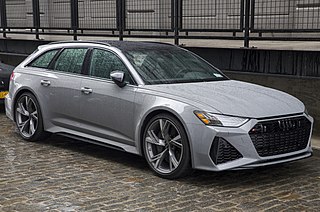
The Audi RS 6 is a high-performance variant of the Audi A6 range, produced by the high-performance subsidiary company Audi Sport GmbH, for its parent company Audi AG, a subsidiary of the Volkswagen Group, from 2002 onwards.

Alpina Burkard Bovensiepen GmbH & Co. KG is an automobile manufacturing company based in Buchloe, in the Ostallgäu district of Bavaria, Germany that develops and sells high-performance versions of BMW cars. Alpina works closely with BMW and their processes are integrated into BMW's production lines, and is recognized by the German Ministry of Transport as an automobile manufacturer, in contrast to other performance specialists, which are aftermarket tuners. The Alpina B7 is produced at the same assembly line in Dingolfing, Germany, as BMW's own 7 Series. The B7's twin-turbo 4.4-litre V8 is assembled by hand at Alpina's facility in Buchloe, Germany, before being shipped to BMW for installation, and the assembled vehicle is then sent back to Alpina for finishing touches.

A motorized bicycle is a bicycle with an attached motor or engine and transmission used either to power the vehicle unassisted, or to assist with pedalling. Since it sometimes retains both pedals and a discrete connected drive for rider-powered propulsion, the motorized bicycle is in technical terms a true bicycle, albeit a power-assisted one. Typically they are incapable of speeds above 52 km/h (32 mph), however in recent years larger motors have been built, allowing bikes to reach speeds of upwards of 72 km/h.
Many countries have enacted electric vehicle laws to regulate the use of electric bicycles, also termed e-bikes. Some jurisdictions have regulations governing safety requirements and standards of manufacture. The members of the European Union and other regions have wider-ranging legislation covering use and safety.

Adaptive cruise control (ACC) is a type of advanced driver-assistance system for road vehicles that automatically adjusts the vehicle speed to maintain a safe distance from vehicles ahead. As of 2019, it is also called by 20 unique names that describe that basic functionality. This is also known as Dynamic cruise control.

Energy-efficient driving techniques are used by drivers who wish to reduce their fuel consumption, and thus maximize fuel efficiency. Many drivers have the potential to improve their fuel efficiency significantly. Simple things such as keeping tires properly inflated, having a vehicle well-maintained and avoiding idling can dramatically improve fuel efficiency. Careful use of acceleration and deceleration and especially limiting use of high speeds helps efficiency. The use of multiple such techniques is called "hypermiling".
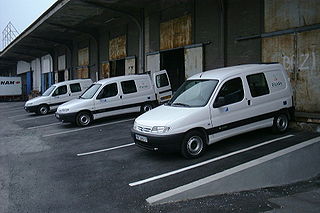
The Citroën Berlingo électrique is a battery-powered version of the first-generation Berlingo range of vans, built and sold between 1998 and 2005. It has a 162 V Saft NiCd battery, a 28 kW Leroy Somer electric motor and has a maximum speed of 95 km/h (59 mph), with a maximum range of 95 km (59 mi) in typical driving. It replaces the C15 électrique.

A collision avoidance system (CAS), also known as a pre-crash system, forward collision warning system (FCW), or collision mitigation system, is an advanced driver-assistance system designed to prevent or reduce the severity of a collision. In its basic form, a forward collision warning system monitors a vehicle's speed, the speed of the vehicle in front of it, and the distance between the vehicles, so that it can provide a warning to the driver if the vehicles get too close, potentially helping to avoid a crash. Various technologies and sensors that are used include radar (all-weather) and sometimes laser (LIDAR) and cameras to detect an imminent crash. GPS sensors can detect fixed dangers such as approaching stop signs through a location database. Pedestrian detection can also be a feature of these types of systems.

A speed limit is the limit of speed allowed by law for road vehicles, usually the maximum speed allowed. Occasionally, there is a minimum speed limit. Advisory speed limits also exist, which are recommended but not mandatory speeds. Speed limits are commonly set by the legislative bodies of national or local governments.

Diesel engines began to be used in automobiles in the 1930s. Mainly used for commercial applications early on, they did not gain popularity for passenger travel until their development in Europe in the 1950s. After reaching a peak in popularity worldwide around 2015, in the aftermath of Dieselgate, the diesel car rapidly fell out of favor with consumers and regulators.

The quadricycle is a European Union vehicle category for four-wheeled microcars, which allows these vehicles to be designed to less stringent requirements when compared to regular cars. Quadricycles are defined by limitations in terms of weight, engine power and speed.

Road speed limits in the United Kingdom are used to define the maximum legal speed for vehicles using public roads in the UK.
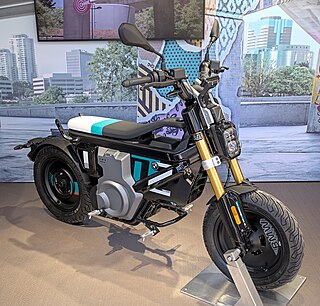
The BMW CE 02 is an electric scooter produced by BMW Motorrad, which markets it as an e-Parkourer for city use.















